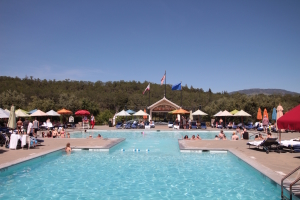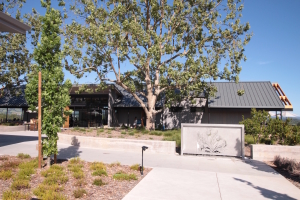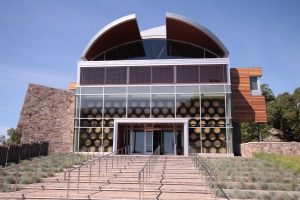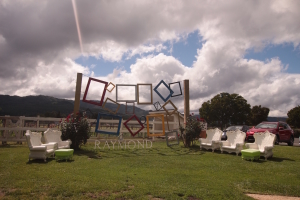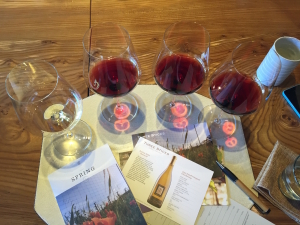Anyone working in the wine industry would jump at the opportunity to visit the US’s Napa Valley. It’s proclaimed as a key wine tourism destination and being so close to Silicon Valley it was always on my ‘wish list’. Surely this was a region abreast of new technologies, amazing customer experiences and wine marketing at its finest?
So when my friend and client Sally Scarborough from Scarborough Wine Co. mentioned she was keen to join me, it was not long before tickets were booked and the planning began. Coincidently, Wine Direct’s ‘Direct to Consumer Napa Workshop’ was being held at that time so we coordinated our trip to take in a presentation of the latest insights and research delivered by a panel of US experts.
Did we have an ambitious schedule? Absolutely. Were there hundreds of wineries to visit? Yes. But this trip was not all about tasting wine. Don’t get me wrong, wine is one of my passions and gaining an insight into the different regional styles of the US was high on the list (I fell in love with Russian River Pinot Noir), but marketing was the name of the game this time round.
After making contact with US marketing colleagues and actively asking for tips and via social media (surprisingly very few US brands using social listening responded to our call outs) people were so generous with their time and their insights made the trip an entirely worthwhile business adventure.
Many of Mastermind’s friends followed our journey on Instagram and Facebook page but for those who missed the happy snaps, here’s a quick rundown of the adventures.
BEAUTIFUL SONOMA
After exploring San Francisco’s urban wineries (what a cool trend!), we high-tailed it to Sonoma, visiting brands such as Buena Vista, Ramsgate, Three Sticks, Patz & Hall, Jordan Winery, MacRostie, Rodney Strong, Kendall-Jackson, Williams-Selyem, Stonestreet, Banshee, The Barlow, MacPhail, VML, Clos du Bois and Red Car (just to name a few). Yes, it was a gruelling schedule (but we survived!).
Many of the smaller producers had pop-up tasting rooms in Healdsburg or Sonoma Square, so we could wander between tasting rooms to discover the wines and then enjoy some of the fabulous restaurants after tasting.
Our time spent in Sonoma was superb – not just because of the quality of the wines, but the wineries often needed to work harder to tell their stories because they were not as well known as their Napa Valley counterparts. Francis Ford Coppola was the exception – who else would place a swimming pool in the middle of the wine tasting experience alongside the Oscars and film memorabilia? While it was extravagant, it was very much on theme. It’s certainly not an experience all brands could replicate but it’s remarkable how engaged the consumers were, and the venue was packed.
In regards to standouts with the application of technology, Buena Vista and Jordan integrated digital seamlessly into the customer experience. The technology added another dimension beyond the wines and made it easier to generate word-of-mouth ‘brand buzz’. As one of the oldest wineries in California established in 1857, Buena Vista works remarkably as an example of an older brand connecting with consumers through modern day mediums – one of the few leveraging virtual reality into its marketing.
Macrostie Winery in Russian River was by far the most exceptional service experience, a combination of delicious wines (the only brand we visited with bottles under screw cap), a stunning vista over the vineyards, gorgeous architecture and design as well as knowledgeable and service-oriented staff who conveyed a genuine love for the brand. Macrostie Winery sets the benchmark.
NAPA VALLEY
Next stop was Napa Valley. If our time in Sonoma was jam-packed, this was a lazy long-weekend compared to the Napa. Check out the list of tasting rooms: Robert Mondavi, Opus One, Hall Wines, Ovid, Beringer, Domaine Chandon, Raymond, Duckhorn, Castello Di Amarosa, Tank Garage, Chateau Montelena, Frog’s Leap, Plumpjack, Robert Sinsky, Cornerstone Cellars, Silver Trident, Gloria Ferrer, Schamsberg and Ma(i)sonry.
The first thing that hits you is Napa Valley’s scale. Much grander than its Sonoma neighbours, the Napa’s tourism dollars are invested into the customer experience. According to Visit Napa Valley, 3.3 million visitors come to the Napa every year. Located just over an hour from San Francisco, visitors are affluent (50% of visitors surveyed reportedly having an annual household income of $100k or more) and many of the wineries have been established for decades, which means that they have long invested in the tourism experience.
We visited a mix of small boutique and larger producers in order to gain different insights. It’s not always the biggest brands that are the exemplary case studies and, as in Australia, brands can become complacent. Service is a key competitive differentiator in the tasting room rather than delivering the most structurally sound wines. The brands we were most looking forward to visiting and who seemed to have big marketing budgets offered poor customer experiences; other brands went above and beyond to make sure we felt welcome. These are the wineries from which we’ll continue to draw inspiration.
It is clear some brands understand the opportunity to sell direct to consumer – their service experience was a well-oiled machine, considering the customer journey and the communications needed to tell their regional, wine and vineyard stories in a way that resonated. Other more traditional brands are still relying on brand presence, without pushing boundaries.
Inspired? Take an armchair tour through these images below for a snippet of our adventures.
- Francis Ford Coppola
- MacRostie Winery
- Buena Vista Winery
- Buena Vista
- Williams Selyem
- Frogs Leap
- Raymond
- Raymond
- Three Sticks
- Hall Wines
- Kendall-Jackson
- Patz and Hall
So what were the key insights?
The wine sampling experience in the Napa is fundamentally different to Australian tasting rooms. Many tasting rooms incorporate food into the experience, require an appointment and charge a fee for the tasting. This allows the staff to service the customers in a more personalised manner and also capture data upfront. A range of different wine flights or experiences are on offer – only a handful of wineries take visitors through the amount of wines you’d typically sample in an Australian cellar door.
Surprisingly the use of digital and social media is lacking in many tasting room experiences, even as a mechanism to capture data or further tell stories. Why? Perhaps servicing the huge volume of visitors coming through the door becomes the priority. I’m keen to explore regions like Oregon to see if its tasting rooms are more integrated and boundary pushing. The exception is Jordan Winery, Duckhorn Vineyards, Cornerstone Cellars and the JCB wineries like Buena Vista and Raymond. These brands are at the forefront. We’re so grateful to their marketing staff for giving us so many insights – it was a real highlight!
- Service was exemplary
This is a region where many of the wineries understand ‘destination marketing’. We did disclose to many wineries that we were members of the Australian wine industry, but it was some of the smaller producers such as Patz & Hall, Three Sticks and Macrostie who impressed us with their knowledge, enthusiasm and exceptional service. Service was a key differentiator – our experience at some wineries was totally altered by the attitude of the staff who failed to read us as customers.
- Wine club acquisition is imperative
With different shipping laws to Australia, US wineries are unable to sell wine directly to consumers in a straightforward way, so understanding customer preferences and signing them up for an ongoing revenue stream is imperative. Many of the smaller winery cellar doors, like Ovid, allow wine club members only to visit, so driving club membership and providing a first class experience is a huge focus for staff. These brands have fabulous events in place for club members such as cruises, dinners and even sporting events.
- Marketing collateral tells brand stories in an integrated manner
There is clearly a large investment made by many of the brands to create the right material to tell brand stories. This specifically designed material helped us gain an appreciation for particular vineyard sites, brand stories and regions, as well as showcasing a range of beautifully integrated collateral for wine club sign ups.
- Email acquisition
Given many of the wineries require bookings, they leverage systems like Vino Visit and Cellar Pass to help with bookings, which in turn captures email addresses. Many had forms for visitors to complete, and as pointed out by Wine Direct, it is those brands who are actively leveraging email as part of the marketing mix that are the standout performers.
See my separate blog post from the Wine Direct seminar on the importance of email acquisition in building email lists for ongoing sales.
- Many use proprietary wine systems to sell more wine
Vin65, Wine Direct and TMRW Engine are all systems many of the brands were using. Those who understand the functionality were clear winners in driving sales. Think of it like having a powerful car and knowing how to use all its features to drive more efficiently. It was great to spend time with these providers and understand the functionality and future plans of their platforms.
I could rave on for months about the specifics of the trip and as you might sense there were lots of insights to be gained. It is a region worth exploring – I can’t wait to share these new ideas with our clients and put them into place to see results we all love!


